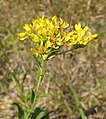| Solidago rigida | |
|---|---|

| |
| S. rigida subsp. humilis | |
| Conservation status | |
 Secure (NatureServe) | |
| Scientific classification | |
| Kingdom: | Plantae |
| Clade: | Tracheophytes |
| Clade: | Angiosperms |
| Clade: | Eudicots |
| Clade: | Asterids |
| Order: | Asterales |
| Family: | Asteraceae |
| Genus: | Solidago |
| Section: | S. sect. Ptarmicoidei |
| Species: | S. rigida |
| Binomial name | |
| Solidago rigida L. 1753 | |
| Synonyms | |
Synonymy
| |
Solidago rigida, known by the common names stiff goldenrod and stiff-leaved goldenrod, is a North American plant species in the family Asteraceae. It has a widespread distribution in Canada and the United States, where it is found primarily east of the Rocky Mountains. It is typically found in open, dry areas associated with calcareous or sandy soil. Habitats include prairies, savannas, and glades.
Description
Soliadgo rigida is a tall, leafy perennial. Its leathery leaves are large for a goldenrod, reaching 3–6 cm (1+1⁄4–2+1⁄4 in) wide and 8–20 cm (3+1⁄4–7+3⁄4 in) long. It produces heads of yellow flowers in the late summer and fall. Its fruit is a wind-dispersed achene.
Galls
This species is host to the following insect induced galls:
- Asphondylia s-rigida-bud-rosette-gall
- Asteromyia carbonifera (Osten Sacken, 1862)
- Gnorimoschema gibsoniella Busck, 1915
- Calycomyza solidaginis Kaltenbach, 1869
Subspecies
- Subspecies
- Solidago rigida subsp. glabrata (E.L.Braun) S.B.Heard & Semple – southeastern + south-central U.S.
- Solidago rigida subsp. humilis (Porter) S.B.Heard & Semple – central + western Canada, central + western United States as far west as the Rocky Mountains
- Solidago rigida subsp. rigida – Ontario, central + eastern U.S.
Conservation
This species is considered by NatureServe to be globally "secure" (G5), which is the lowest level of conservation concern assigned. However, it is known to be rare on the local level, due to its declining grassland habitat. It is listed as endangered in Connecticut, New Jersey and Pennsylvania. It is listed as endangered and extirpated in Maryland, as threatened in New York, and as historical in Rhode Island.
Native American ethnobotany
The Ojibwe use a decoction of root as an enema, and take an infusion of the root to treat "stoppage of urine". The Meskwaki make the flowers into a lotion and use them on bee stings and for swollen faces.
References
- ^ "Solidago rigida". The Global Compositae Checklist (GCC) – via The Plant List. Note that this website has been superseded by World Flora Online
- "Solidago rigida". County-level distribution map from the North American Plant Atlas (NAPA). Biota of North America Program (BONAP). 2014. Retrieved 23 January 2018.
- ^ Semple, John C.; Cook, Rachel E. (2006). "Solidago rigida". In Flora of North America Editorial Committee (ed.). Flora of North America North of Mexico (FNA). Vol. 20. New York and Oxford: Oxford University Press – via eFloras.org, Missouri Botanical Garden, St. Louis, MO & Harvard University Herbaria, Cambridge, MA.
- Kaltenbach, J.H. (1869). "Die deutschen Phytophagen aus der Klasse der Insekten ". Verh. Naturh. Ver. Preuss. Rheinl. 26 (3, 6): 106–224.
- Oligoneuron rigidum NatureServe
- "Connecticut's Endangered, Threatened and Special Concern Species 2015". State of Connecticut Department of Energy and Environmental Protection Bureau of Natural Resources. Retrieved 19 January 2018. (Note: This list is newer than the one used by plants.usda.gov and is more up-to-date.)
- NRCS. "Oligoneuron rigidum". PLANTS Database. United States Department of Agriculture (USDA). Retrieved 19 January 2018.
- Densmore, Frances, 1928, Uses of Plants by the Chippewa Indians, SI-BAE Annual Report #44:273-379, page 364 (Note: This source comes from the Native American ethnobotany database (http://naeb.brit.org/) which lists the plant as Oligoneuron rigidum var. rigidum. Accessed 19 January 2018
- Densmore, Frances, 1928, Uses of Plants by the Chippewa Indians, SI-BAE Annual Report #44:273-379, page 348 (Note: This source comes from the Native American ethnobotany database (http://naeb.brit.org/) which lists the plant as Oligoneuron rigidum var. rigidum. Accessed 19 January 2018
- Smith, Huron H., 1928, Ethnobotany of the Meskwaki Indians, Bulletin of the Public Museum of the City of Milwaukee 4:175-326, page 217218 (Note: This source comes from the Native American ethnobotany database (http://naeb.brit.org/) which lists the plant as Oligoneuron rigidum var. rigidum. Accessed 19 January 2018
| Taxon identifiers | |
|---|---|
| Solidago rigida |
|
